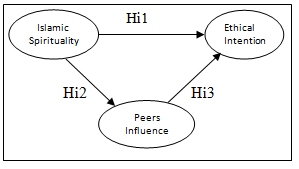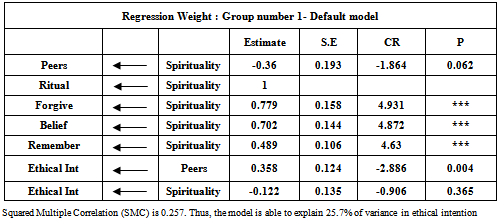-
Paper Information
- Next Paper
- Previous Paper
- Paper Submission
-
Journal Information
- About This Journal
- Editorial Board
- Current Issue
- Archive
- Author Guidelines
- Contact Us
Human Resource Management Research
p-ISSN: 2169-9607 e-ISSN: 2169-9666
2013; 3(1): 39-42
doi:10.5923/j.hrmr.20130301.08
Islamic Spirituality and Peers Influence as Antecedents of Ethical Intention of Public Servants: A Structural Equation Modelling (SEM) Approach
Mohd Farid Abd Latib , Muhammad Safizal Abdullah , Mohd Zainudin Othman , Nik Kamariah Nik Mat
Othman Yeop Abdullah Graduate School of Business, Universiti Utara Malaysia, Sintok, 06010, Kedah Malaysia
Correspondence to: Nik Kamariah Nik Mat , Othman Yeop Abdullah Graduate School of Business, Universiti Utara Malaysia, Sintok, 06010, Kedah Malaysia.
| Email: |  |
Copyright © 2012 Scientific & Academic Publishing. All Rights Reserved.
The purpose of this study is to examine the antecedents of ethical intention among the public servants in Malaysian public service sector. All variables were measured using 7- points interval scale; Islamic spirituality (18 items), peers influence (6 items) and ethical intention (18 items) as exogenous variables. Questionnaires were distributed to 200 public servants in public primary and secondary schools in Kedah state based on a random sampling method. A respond rate of 78.5% (157 respondents) was obtained during data collection phase and 152 were usable. The data was input into SPSS 18 and analyzed using Structural Equation Modelling (SEM) through AMOS 17. The result shows that the goodness of fit indices of structural equation model are adequate at GFI=0.941, p-value=0.066 RMSEA=0.046, ratio (cmin/df)= 1.326 and TLI= 0.959. The finding supports one significant direct effect in the revised model, thus supporting the hypothesis peer influence is significantly influence ethical intention (β= 0.358, c.r = 2.886, p<0.004. The result is discussed in the perspective of public servant towards ethical intention.
Keywords: Islamic Spirituality, Ethical Intention, Peers Influence
Cite this paper: Mohd Farid Abd Latib , Muhammad Safizal Abdullah , Mohd Zainudin Othman , Nik Kamariah Nik Mat , Islamic Spirituality and Peers Influence as Antecedents of Ethical Intention of Public Servants: A Structural Equation Modelling (SEM) Approach, Human Resource Management Research, Vol. 3 No. 1, 2013, pp. 39-42. doi: 10.5923/j.hrmr.20130301.08.
Article Outline
1. Introduction
- Several decades ago many previous studies have documented evidence of unethical behavior in organizations. The importance of integrity to public service is to create an administration and public services that are efficient and disciplined by inculcating moral values to overcome problems and weaknesses in various aspects of governance such as financial management, , handling of disciplinary cases, corruption, abuse of power, law and religion (Nasional, 2006).To strengthen integrity in public service delivery, various policies have been implemented by the government such as the Dasar Etika Perkhidmatan Awam and Konsep Perkhidmatan Cemerlang; Dasar Bersih Cekap dan Amanah; Dasar Nilai dan Etika Perkhidmatan Awam; Dasar Penerapan Nilai-Nilai Islam Dalam Perkhidmatan Awam and Dasar Tonggak Dua Belas (Hairi Nik Omar, 2012). The government's commitment to promote integrity in the public service is done from time to time through a variety of ways. These include the establishment of the Biro Pengaduan Awam (BPA) in year 2000 that allows the public to channel their complaints directly to the Prime Minister (CPA, 2010) and the Pelan Integriti Nasional (PIN) in 2004[1].Unfortunately, the performance and integrity of the civil service in Malaysia is still at a low level evidenced by Malaysia’s ranking at 22nd in the International Corruption Perception Index Report (CPI) in 1995. The rank drop further to 37th in 2003 and it continues to drop to 56th in 2010. These statistics show that Malaysia is among the countries which have high rates of corruption (Transparency International, 1995 to 2010). In the last 15 years, the average score of Malaysia’s CPI index has declined significantly from 28.5 points in 1995 to 4.4 points in 2010. During this period, issues such as corruption and inefficiency of public service delivery are becoming increasingly serious[1].A study should be conducted to identify the underlying problems of this scenario, even though in 2004 the government had implemented the National Integrity Plan to emphasize the integrity and moral values. Sadly, the National Integrity Plan has not shown promising results and the amount of complains from the public about the public service keep on increasing every year[2]. This fact is an alarming scenario, and it becomes the main focus of the government in the 10th Malaysia Plan.
2. Literature Review
- Islamic spirituality and Ethical Intention Islamic Spirituality (IS) has a comprehensive feature of intrinsic motivation, which inclines to move Muslim workers toward honorable behavior within the organization[3]. Reference[4] in their study found that most of the employees who were interviewed indicated that "soul" have been damaged by the workload faced.[5] shows that from the 1980s to the 1990s, there were many companies have implemented internal changes in an effort to improve employees’ morale. However, with the evolution and transformation of the company's new layout, that effort does not come to fruition because employees’ morale remains low. This development prompted many scholars in the field of psychology to try to identify effective ways to stimulate employees’ inner strength through the introduction of spirituality element in organizational management.[6] agreed that the confusion about life and the desire to find meaning in life, has led to an increase in religious curiosity. Many individuals faced spiritual emptiness, moral uncertainty, confusion of social values, greed, and often commit criminal acts. This phenomenon has resulted in an imbalance in life in terms of material and spiritual, which also creates a serious impact on the values of ethics, particularly in the workplace.In general, spirituality is considered the essence of life that transcends themselves and their consciousness[7];[8]. In his five-staged theory of human needs, Maslow (1969) explains that spirituality is the highest level of needs, beyond self-consciousness, and is part of the essence of human existence. Without spirituality, human nature is incomplete because it is the core of a happy life[9]. Good value in Islam is the faith and devotion to Allah the Almighty. This is the pillar of values and ethics in Islam. Without a deep understanding of this basic, any acts or employment is not recognized by Allah the Almighty, even if a person has met the standard of organization's values and ethics[10].Peer Influence and Ethical IntentionResults of studies investigating the relative effect of peers on ethical decision making have consistently indicated that peers exert a more substantial effect than managers on employees[11],[12),[13] in[14].According to[15] unethical behavior can be learned through relationships with peer groups in which an unlawful act is considered as a way to be accepted in a group. Past studies show that the influence of a friend or a group is also involved in influencing individual ethical inclination. According to[16] an individual’s unusual behavior was often agreed or supported by a group, even though the crime can be carried out by an individual[17]. The theory of social identity explained that an individual in the group sees themselves as part of the same social category[18]. Part of this process involves the formation of social identity of individual who highlight or show the similarities with the members of the group in term of their common faith, families, communities, professions, and countries[19].Islamic Spirituality and Peer InfluenceAccording to a study by[20], American citizens have high spiritual and lack of ethics in decision making. However, the study also found that peer influence is more important for the citizens of Norway compared to America in making ethical decisions. Social identity theory also explained that culture can influenced a person's spirituality, and eventually spirituality will affect ethical intention. This study will attempt to explore the relationship between spirituality and the influence of peers on the formation of ethical intentions of an individual.Underpinning TheoryThe study’s conceptual framework was adapted from (Ajzen, 1991) is Theory of Planned Behaviour (TPB) model. TPB was designed to conceptualize, measure, and empirically identify factors that determine behavior and behavioral intention[21].[22], defines intention as the probability of a dimension that involves the relationship between himself and some action.According to TPB, behavior is determined by the individual’s intention to perform the behavior. Intention is determined by three factors; attitudes toward the behavior, which are informed by beliefs needed to engage in the behavior; subjective norm, the social pressures to perform or not to perform the behavior and perceived behavioral control refers to people's perceptions of their ability to perform a given behavior.Another major source of individual values that is increasingly linked to ethical thinking and behaviour is spirituality. The study will adapt the TPB as a framework and Islamic spirituality will function as an independent variable to ethical intention, while subjective norms will be a mediator between Islamic spirituality and ethical intention. Islamic spirituality is linked to ethical intention trough Social Identity Theory which will attempt to explore the role of Islam in predicting the ethical decision making among the Malays.Conceptual framework of the study is shown in Figure 1 as follows;
 | Figure 1. Research Framework |
3. Methodology
- To fulfilling the quantitative nature of this study, then a systematic planning has been planned since the beginning of the study. It is intended that the data collected is accurate and adequate[23]. In this study, 200 questionnaires were distributed to public servants in public primary and secondary schools in Kedah state based on a random sampling method. 157 questionnaires were returned (78% respond rate) and 152 were usable. SEM was employed to path analysis. From the hypothesized model, (Figure 1), there is one regression coefficients: (1) Islamic spirituality is an independent variable, peers influence is a mediator; and ethical intention is the dependent variable.Each variables was measured as follows: Islamic spirituality was adopted from[3] and (18) items measured by 7-point interval-scale of (1)- strongly disagree to (7)- strongly agree); peers influence was adopted from[24] - (6 items measured by 7-point interval-scale of (1)- strongly disagree to (7)- strongly agree); ethical intention was adopted from[25] - (18 items measured by 7-point interval-scale of(1) strongly disagree to (7)- strongly agree). The internal consistency (cronbach’s alpha) values for each study’s instrument are shown in Table 1 below. All instruments used in this study have a high level of consistency (α > 0.8).
|
4. Results
- In order to get rid of outliers, data cleaning were done and 5 cases (55, 94, 100, 24, and 113) were excluded. Normality test were also performed on every item, and items which were not normal were transformed using CDFNORM until normality were achieved. The revised model achieved the goodness-of-fit criteria as shown in Table 2 below.
|
|
5. Discussion
- This study has established one direct causal effects; Peer influence is significantly influences ethical intention. However, the study found out that there is no effect between Islamic spirituality and both ethical intention and peer influence. Thus, both Hi1 and Hi2 are not supported. The effect of peer influence on ethical intention was concurred with past studies by Hollinger and Clark (1983), Fu and Deshpende (2011). The ethical intention among public servants can be influenced by their peers and co-workers. Thus, organization should encourage the establishment of a more ethically-conducive working environment in order to promote workers to behave ethically. In doing so, authority should give more encouragement and ensure the safety of workers who come forward to report any wrongdoings or criminal acts.
ACKNOWLEDGEMENTS
- We would like to thank Prof Dr. Nik Kamariah Nik Mat for their helpful comments and assistance on an earlier version of this paper.
 Abstract
Abstract Reference
Reference Full-Text PDF
Full-Text PDF Full-text HTML
Full-text HTML